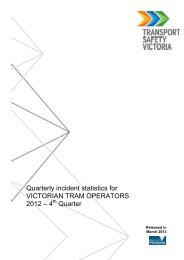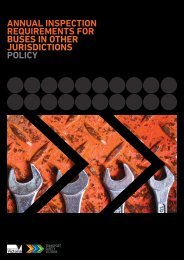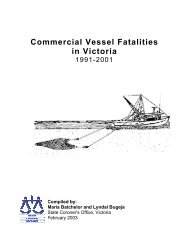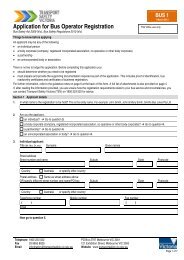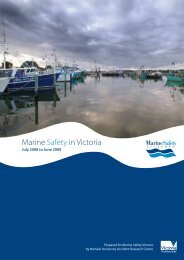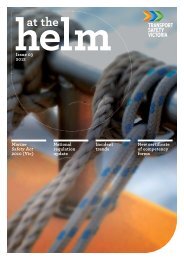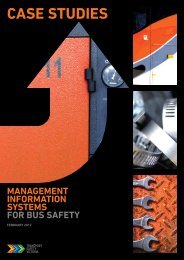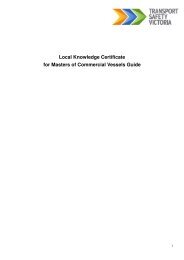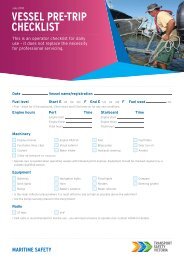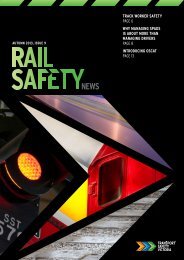Marine Safety in Victoria Report 2007-2008 (PDF, 1.3 MB, 72 pp.)
Marine Safety in Victoria Report 2007-2008 (PDF, 1.3 MB, 72 pp.)
Marine Safety in Victoria Report 2007-2008 (PDF, 1.3 MB, 72 pp.)
Create successful ePaper yourself
Turn your PDF publications into a flip-book with our unique Google optimized e-Paper software.
3.3.4 Vessel occupant details, PFD wear<br />
Data on the number of crew and passengers were available for 88 of the 90 vessels. Seventy-four percent<br />
(n=67) of the vessels <strong>in</strong>volved <strong>in</strong> ‘serious <strong>in</strong>cidents’ carried no crew and 83% (n=75) carried no passengers.<br />
The vessels carry<strong>in</strong>g crew (n=23) carried between 1 and 23 crew members. Fifteen vessels carried<br />
passengers (range 3-100 passengers).<br />
The serious <strong>in</strong>cident report form requires <strong>in</strong>formation to be completed on the person <strong>in</strong> charge of the<br />
vessel and any other persons <strong>in</strong>volved. Data on gender of persons <strong>in</strong>volved showed that 58% were male<br />
and 42% female. Age was given for person <strong>in</strong>volved <strong>in</strong> 57% of <strong>in</strong>cidents (n=51). The mean age was 52<br />
years (age range 30-71 years).<br />
The licence type held by the person <strong>in</strong> charge of the vessel <strong>in</strong>volved <strong>in</strong> the <strong>in</strong>cident was reported for 63%<br />
of <strong>in</strong>cidents. Thirty-seven percent were pilots, 7% were Pilot Exempt Master, 6% were coxswa<strong>in</strong>, 4% were<br />
Master Class 5, 2% were Master Class 4, and 1% was Ski<strong>pp</strong>er Grade 2. Two held no boat<strong>in</strong>g license (2%).<br />
The person’s ‘activity’ was undef<strong>in</strong>ed for 76% of <strong>in</strong>cidents and the ‘role of the person at the helm’ was<br />
‘undef<strong>in</strong>ed’ for 99% of <strong>in</strong>cidents. All of 90 <strong>in</strong>cidents were coded to zero (‘0’) for PFD wear.<br />
3.3.5 Seasonal distribution<br />
Figure 2 shows the seasonal pattern of commercial mar<strong>in</strong>e <strong>in</strong>cidents, presented separately for ‘response<br />
only’ and ‘serious <strong>in</strong>cidents’. The peak season for serious <strong>in</strong>cidents was Spr<strong>in</strong>g (n=29, 32%) followed by<br />
Summer (n=23, 26%). Response only <strong>in</strong>cidents peaked <strong>in</strong> Autumn (n=16, 33%), due only to a high number<br />
of <strong>in</strong>cidents <strong>in</strong> May.<br />
Figure 2 Distribution of commercial vessel <strong>in</strong>cidents by month of <strong>in</strong>cident,<br />
<strong>Mar<strong>in</strong>e</strong> Incident <strong>Report</strong><strong>in</strong>g system <strong>2007</strong>/8 (n=139)<br />
Jun<br />
May<br />
2<br />
6<br />
8<br />
9<br />
Serious <strong>in</strong>cident (n=90)<br />
Response only (n=49)<br />
Apr<br />
4<br />
4<br />
Mar<br />
3<br />
9<br />
Feb<br />
4<br />
4<br />
Month<br />
Jan<br />
Dec<br />
2<br />
4<br />
9<br />
10<br />
Nov<br />
2<br />
11<br />
Oct<br />
4<br />
13<br />
Sep<br />
5<br />
7<br />
Aug<br />
2<br />
7<br />
Jul<br />
4<br />
6<br />
0 2 4 6 8 10 12 14<br />
Frequency<br />
22



